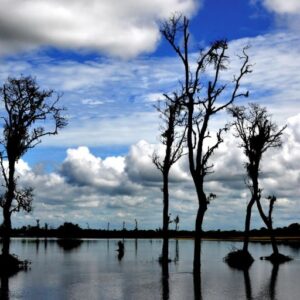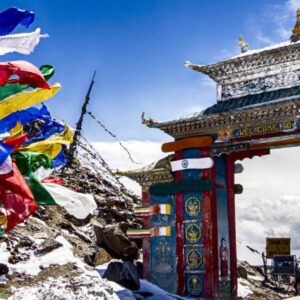DAY 1 –Guwahati- Shillong
Received at Guwahati airport and later drive to Shillong (130km/ 03 ½ hrs). On arrival check in the hotel for 03 nights. Evening at leisure. Overnight at the hotel
GUWAHATI – Situated on the southern bank of the River Brahmaputra in the Kamrup District of Assam, Guwahati is a fast growing premier city. It is the gate way to the North Eastern States of India and a principal center of socio cultural, political, industrial and trade and commerce of the entire region. Dispur, the capital of Assam is a part of Guwahati. In earlier years, this city was full of areca nut trees rappled by pan creepers. Hence this city subsequently got the name Guwahati. The word ‘Guwa’ in Assamese means areca nut and Hat means market.
SHILLONG – Shillong is the capital city of the state as well as the district headquarter of East Khasi Hills District. The name Shillong is derived from U-Shyllong, a powerful deity, and is situated at an altitude of 1,491m above sea level. This beautiful city is 103kms from Guwahati, the nearest air and train link. The presence of many well reputed educational institutions, many of them by missionary groups make Shillong the hub of education for the entire north-east.
DAY 2 – Shillong-Cherrapunjee-Shillong
Today we take a day excursion to Cherrapunjee (72 kms / 02 1/2 hrs- FROM Ri-Kynjai), 1300mt – once the heaviest rainfall area in the world. The drive will give us a spectacular view of deep gorges and the rolling hills luxurious with tropical vegetation that boast an innumerable variety of ferns, moss and orchids. At Cherrapunjee, we explore the Arwah Lumshynna cave, Nohkalikai Falls, Nohsngithiang Falls, Eco Park at Mawsmai, etc. En-route we also visit the Mawphlang Sacred Forest, for a nature walk. We then return to the hotel for the night.
Mawphlang Sacred Forest – Just 28 kms away from Shillong is Mawphlang Sacred Forest, one of Meghalaya’s most celebrated sacred forests, as the world over, are steeped in spiritual belief and held in great veneration. They also represent some of the earliest representations of preserving the ancient ecosystems. This is a dense forest where the Lyngdoh (chief) used to offer sacrifices and prayers. Not a branch should be broken or else a curse may befall on that person. This grove is surrounded by a lush green valley and a great variety of plants like orchids, include the carnivorous varieties and ferns grow here.
Cherrapunjee – Cherrapunjee is 56 kms from Shillong and is literally the high point of any visit to Meghalaya -a destination renowned all over the world for receiving the highest rainfall in the world. Set against the backdrop of breath-taking landscape, it is a place to discover the Indian summer monsoons, a unique annual meteorological phenomena directly influenced by the south west monsoon and the north east winds. The heavy monsoon rains over these mountains undoubtedly creates in Sohra one of the rarest biodiverse vegetations in the world. Truly a beautiful corner in north-east India, waiting to be discovered and explored. The old Cherra or Sohrarim was the original Cherra village but with the coming of the British who set up their headquarters further south, the village came to be known as ‘Sohra’ or present day Cherrapunjee. It was here that the British realized the enormity and intensity of the rainfall and set up a meteorological office for measuring the rain. Sohra was declared by the British to be the capital of Assam in 1832, which was later shifted to Shillong in 1866 due to the inclement weather.
Nohsngithiang Falls also known as Mawsmai falls, is 1 km south of Mawsmai village and derives its name from where the waterfalls are situated- in a south westerly position and get illuminated by the sun from dawn to sunset. The vibrant colours of the setting sun on the waterfalls make it a sight to behold as at times one can even see the colours of the rainbow emitting from them.
Nohkalikai falls: A hauntingly beautiful waterfall, cascading down from the top of the gorge to the mystic deep green pool below, reminds one of the tragic legend associated with it- of a grief stricken mother who plunged to her death, unable to overcome her sorrow of the murder of her daughter by her husband.
The Arwah Lawshynna Cave Location: East Khasi Hills District, Sohra This Cave lies in the slope of U Lum Lawshynna Hill. It is approximately one kilometre in length. It is adorned with different types of carving and formation designed by nature itself which adds lot of beauty to the place. A stream runs through the cave from beginning till the end, making us feel as if we are walking in a river. The height is very high and the breadth is very wide, but it gets narrower and narrower as we move further. Birds and bats frequently visit this cave and make it their home. The cave is covered by a thick forest, called the ‘Law Shynna’. Different types of local species of trees, orchids, wild flowers, shrubs, bamboos and coloured leaves are found in this forest. On the way to the cave, there is a viewpoint, from where we can see the beautiful Wahkaba Falls, the natural landscape and the river which flows to Bangladesh through Nongpriang Village and Sohkhmi Village. The hill where the cave is located is called ‘U Lum Shynna’. This hill is very high and it overlooked the Sohra town and even the plains of Bangladesh could be seen from this hillock. That is why it is called Lum Shynna which literally means Clearview. All through this hill, from North to South runs the David Scott Bridle path build by the British which once upon a time connects the Brahmaputra Valley and the Surma Valley in Bangladesh. This path was used by people to go to Shillong or Laban, to the market and to Bangladesh for trade. This path is still visible now, while some parts are destroyed due to soil erosion and landslide caused by coal mining. Resting places for those who are tired are also found along the route. At the foot of this hillock, there are the remnants of the ‘Kyntursniang Village’ a historical site where foundation of the present Sohra Syiemship was laid by Buh Sing Syiem and his myntris.
DAY 3 – Shillong-Dawki-Mawlynnong-Shillong
Post breakfast we drive to Dawki (04hrs) close to Bangladesh border. Later we visit Mawlynnong Village. Place of interest to be found here includes natural beauty, excellent day walks for birding, a haven for botany, living root bridge crossing numerous streams, rivers and cascading waterfalls. Later drive back to Shillong and overnight
Dawki: Just across the border of Bangladesh near the Tamabil-Dawaki checkpost flos the beautiful Dawki river with greenish-bluish water so clear that one can see the botteom of the river even from as high as the bridge over the river. It flows very close to the customs check post at Dawki with Jaintia Hills District on one side and East Khasi hills District on the other. As it enters the plains of Bangladesh it loses its beautiful color and becomes heavily strewn with rocks and small boulders.
Mawlynnong Village has earned the distinction of being the cleanest village in India. It is situated 90 kms. from Shillong and besides the picturesque village, offers many interesting sights such as the Living Root Bridge and a strange natural phenomenon of a boulder balanced on a rather small rock. Mawlynnong nestled in the pristine hill state of Meghalaya, is very close to the Indo-Bangla border. This cute and colourful little village is known for its cleanliness. The main occupation of the villagers is agriculture. They mostly grow betel nut. About 82 households live in Mawlynnong. Keeping the surrounding environment clean is an age old tradition. Discover India magazine declared the village as the cleanest in Asia in 2003. Dustbins made out of bamboo are found all along the village. Everyone makes it a point that dirt and waste are not thrown everywhere. All the waste from the dustbins is collected and kept in a pit, which the villagers use as manure. The villagers are now on a mission to ban plastic. The village with cent per cent literacy is conscious and they are spreading the message of conservation and protection of the forest. Locals plant trees to ensure that the virgin forest is kept intact and also replenished. Mawlynnong’s fame is now drawing an endless stream of guests from across the country and abroad. Mawlynnong is an artist’s delight and the sort of getaway that would titillate creative writers and poets.
DAY 4 – Shillong- Guwahati, Assam
Post breakfast we visit DBCIC Museum and later drive to Guwahati. On arrival check in at hotel for 01 night. Later we visit Kamakhya Temple. Evening enjoy a sunset cruise on River Brahmaputra. Overnight at the Hotel.
Don Bosco Centre for Indigenous Cultures (DBCIC): is a three-in-one Institution combining a museum with a research and publication centre, for promoting and preserving the rich cultural heritage of North East India -a unique fusion of all the sister states under one roof. DBCIC contains seventeen galleries displaying cultural artefacts and paintings. It offers study and research facilities throughout its specialised library of 10,000 volumes, a media hall and a conference hall. It is frequented by school students and older research students and anthropologists. DBCIC Museum : The Museum has the following holidays – All Sundays, January 1, January 26, January 31, August 15, November 2, Second last Monday in November, December 22-25 (both days inclusive), December 31, Thursday before Easter to Easter Monday (both days inclusive).
Kamakhya Temple: Situated atop the Nilachal hills, the foremost shrine of Assam, Kamakhya Temple dominates Guwahati, as much as the great Brahmaputra river. Kamakhya is an ancient seat of tantric and shakti cults of Hinduism. A rush of devotees throng the Temple during the Ambubachi Puja celebrated in June.
DAY 5 – Guwahati, Assam Fly out
Later in time transfer to Guwahati airport to board flight for onward destination.








Reviews
There are no reviews yet.